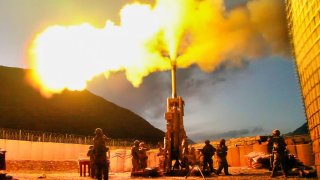New Military Aid to Ukraine Actually Upgrades America's Army
Equipment transfers to Ukraine have not only allowed the U.S. to cripple the Russian military at the cost of three percent of our defense budget, but they have also provided an opportunity for the Pentagon to modernize the Army’s aging arsenal.
“I would rather send bullets to Ukraine than American boys,” House Speaker Mike Johnson said last week before the chamber passed military aid for Ukraine, Israel and Taiwan. In a two-fer for impact, sending ammo overseas will help U.S. servicemembers upgrade their kit sooner, faster and better as a result.
As Congress prepares for final passage of the latest spending package to provide funding to allies engaged in multiple wars, these funds are really an overdue investment in America’s defense industrial base and by extension the troops.
The national security supplemental bill provides $29.5 billion to backfill an increasingly-depleted US arsenal with more than three-fourths of the proposed supplemental funding is actually spent right here in the US.
Army leaders have been clear that this is an urgent need. The Army’s acquisition chief Doug Bush has noted the Army cannot reach its target for artillery production without additional funding. General Glenn Dean has emphasized that the hundreds of vehicles supplied thus far to Ukraine have “not yet been resourced for replacement.”
Backfilling US stocks is a useful upgrade for the U.S. Army, which has dug into its own stockpiles to equip allies. Historically, modernization funding is treated as a billpayer where year after year funds are deferred to pay other immediate expenses. This continued trend results in an increasingly aged and hollowed force that must increasingly trade capacity for capability.
However, the latest security bill provides funding to “replenish” aging Cold War-era equipment with upgraded and modernized versions of those platforms.
Increasingly antiquated light armored ground vehicles, like the Humvee, have long been scheduled for replacement by the modern Joint Light Tactical Vehicle (JLTV). these have proven valuable to the Ukrainian army, providing needed transport capacity and even destroying Russian tanks when equipped with anti-tank missile launchers, they are showing their age.
Other platforms, such as the M113 Armored Personnel Carriers, provide armored transport and medevac capacity to Ukrainian forces on the frontline. Previously, these M113s had been gathering dust in Army warehouses with some having been deployed over 50 years ago in the Vietnam War. Now, with supplemental funding, these can be transferred to Ukraine and replaced by modern equivalents.
Additionally, Bradley Infantry Fighting Vehicles, another Army Cold War staple, have been proving their worth in Ukraine. The variant supplied to Ukraine, the M2A2, was first introduced into U.S. Army service in 1988. These older platforms are being replaced with upgraded Bradley A3s, which provide American forces with modern communications systems, enhanced survivability, improved lethality, and better mobility.
The same can be said for the dated models of Stryker armored vehicles that are being sent to Ukraine—dated models which far outclass their Soviet-built counterparts that the Ukrainian army must also work with. These dated variants sent to Ukraine can be replaced with new modernized Strykers that equip soldiers with digital systems, more power, and better weapons.
Even support and logistic platforms, such as the Heavy Expanded Mobility Tactical Truck (HEMTT) truck and Family of Medium Tactical Vehicles, have proven crucial to Ukrainian battlefield successes. These systems have been long overdue for upgrades stateside and can now be replaced with modernized versions like the HEMTT A4 and FMTV A2.
It’s not just armored vehicles, either. The national security supplemental will allow the U.S. military to update its supply of critical munitions, as well. The PATRIOT PAC-2 missiles supplied to the Ukrainians have shot down drones, glide bombs, and even hypersonic missiles. The PAC-2 missile was first developed in the 1980s and still makes up a significant stockpile PATRIOT battery munitions.
The funded transfer and replenishment of PAC-2 missiles to Ukraine will allow the Army to fill its stocks with the upgraded PAC-3 missiles. This allows for the launcher to fire more missiles, provide greater maneuverability, and pack a bigger punch against advanced threats.
Furthermore, in addition to providing a boost to U.S. production of artillery shells, the supplemental allows the Army to send dated stocks and replace them with fresh ammo. Service leaders are busy trying to produce a modern 155 round that can “home in on an armored vehicle even in a GPS-denied environment” and “should strike well beyond the range of current 155mm rounds.”
This supplemental funding will also allow further transfer of long-range strike capabilities like the Army Tactical Missile System (ATACMS) been successfully employed by the Ukrainian to strike targets in the Russian rear and score critical victories. The ATACMS has been in service since 1986 and is now outclassed by many other missiles in the Army’s arsenal, such as the Precision Strike Missile, which boasts an over doubled 400 mile range. With funds to backfill these weapons, the U.S. Army can more rapidly move to modernize and ramp up production of long range fires.
These equipment transfers to Ukraine have not only allowed the U.S. to cripple the Russian military at the cost of three percent of our defense budget, but they have also provided an opportunity for the Pentagon to modernize the Army’s aging arsenal.
Turns out that what is good for our friends and partners is also good for soldiers; a win-win.
About the Author
Mackenzie Eaglen is a senior fellow at the American Enterprise Institute (AEI), where she works on defense strategy, defense budgets, and military readiness. She is also a regular guest lecturer at universities, a member of the board of advisers of the Alexander Hamilton Society, and a member of the steering committee of the Leadership Council for Women in National Security. You can follow her on Twitter @MEaglen.


